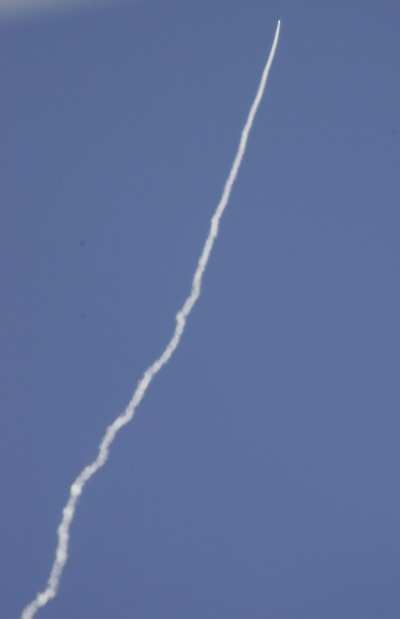SpaceShipOne Wins X-Prize
Burt Rutan's SpaceShipOne, piloted by former Navy test pilot
Brian Binnie, reached an altitude of 368,000 feet Monday, meeting
the criteria for the $10 million Ansari X-Prize.

The flight appeared smooth, without the stomach-churning rolls
that plagued the first qualifying flight.
In the process of apparently winning the X-Prize, Rutan's small,
privately-built spacecraft also broke the altitude record set back
in the 1960s by the X-15.
A crowd of thousands -- much larger than during the past two
suborbital shots -- watched as Binnie made the long, monotonous
climb to launch altitude inside SpaceShipOne, slung below its
mothership, White Knight. SpaceShipOne's pilot for the past two
suborbital flights, Mike Melvill, piloted White Knight for this
attempt.

"This is the true frontier of transportation," said FAA
Administrator Marion Blakey, who watched the flight from near the
runway at the Mojave Spaceport. "It feels a little bit like Kitty
Hawk must have."
After the flight, SpaceShipOne was towed in behind a pickup
truck; the crowd went wild. The pilot that flew the flight, the
engineer that designed it, the key personnel that made it happen
stepped up on the podium -- a speech was definitely in order.
Burt Rutan took a moment after the flight to plug a Discovery
Channel documentary on the flight: "Last night was a phenomenal
experience for us, because we had not seen the documentary done by
Discovery. What they did there was to show very, very deep inside
our program... it gives you a phenomenal feel for how difficult it
was, and... if you haven't seen it it's an amazing piece on
development of a private spaceship." The next installment of the
documentary, covering the two X-Prize flights, airs on October
7.

Rutan stressed the safety of his system. "We are building a
system to take passengers into space, it has to be 100 TIMES safer
than anything that has flown in space before." He delivered a
couple of his trademark digs at NASA, and pointed out that the
unique, innovative "feathered" re-entry is the safest re-entry yet
devised, and that the engine of SpaceShipOne is a safe engine that,
unlike many rocket engines, is non-explosive. Dr. Peter
Diamandis later pointed out that 18,000 NASA employees, space
enthusiasts who never had a chance before to fly in space, now
do.
Pilot Brian Binnie, 51, praised the team behind the machine, and
brought his wife on stage to take her fair share of the credit.
Binnie reported that they had passed, "for sure," 360,000 feet, and
according to his in-cockpit instrumentation should have achieved
375,000 feet. He also called SpaceShip pilots Mike Melvill and
Peter Siebold to the stage to share in his glory. Flight Director
Doug Shane stood behind him.
"Let me say I thank God that I live in a country where this is
possible," Binnie said. "And I really mean that. There's no place
on Earth that you can take this flag and take it up to space."
The rocket ship, built and operated by Burt Rutan's Scaled
Composites of Mojave and powered by an innovative, ultra-safe
engine made by SpaceDev of Poway, CA, appeared to rise absolutely
straight into the sky, without any anomalies. Binnie, whose test
flight experience spans craft from Naval weapons tests to the
unusual Roton atmospheric test vehicle, was understandably
extremely pleased. It was one flight, it was one prize, but it was
also a marker for the threshold of a new era in space travel.
Diamandis asked the crowd, "who thinks you can fly in space
now?" and was rewarded with a lusty cheer. When he asked who
thought they would in the next five years, the shouts were not
quite as many or quite as loud. The ebullient Diamandis just
grinned: he now has a track record of doing the impossible.
 Classic Aero-TV: The Switchblade Flying Car FLIES!
Classic Aero-TV: The Switchblade Flying Car FLIES! ANN FAQ: Q&A 101
ANN FAQ: Q&A 101 ANN's Daily Aero-Term (04.12.24): Discrete Code
ANN's Daily Aero-Term (04.12.24): Discrete Code ANN's Daily Aero-Term (04.13.24): Beyond Visual Line Of Sight (BVLOS)
ANN's Daily Aero-Term (04.13.24): Beyond Visual Line Of Sight (BVLOS) ANN's Daily Aero-Linx (04.13.24)
ANN's Daily Aero-Linx (04.13.24)





